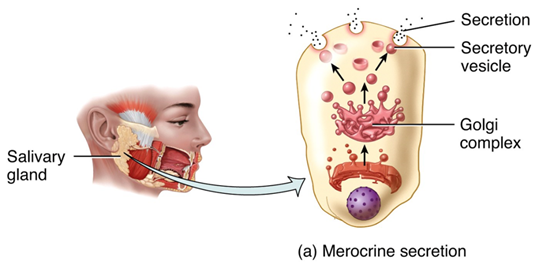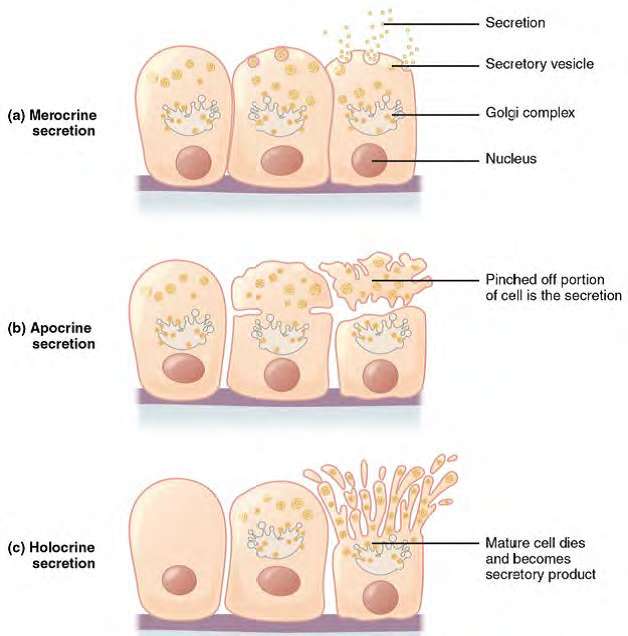What is Glandular Epithelium? What are the types of Secretion?
Epithelial glands are an example of simple organs. Glands that secrete their contents directly into the blood are called endocrine glands. Glands that secrete their contents into a lumen or duct are called exocrine glands. We will look at some common types of exocrine glands (endocrine glands are studied later).
Exocrine Glands secrete products through ducts to the surface of the skin or into the lumen of a hollow organ (examples include the sweat ducts or pancreatic ducts). Secretions of the exocrine gland include mucus, sweat, oil, earwax, saliva, and digestive enzymes. Examples of exocrine glands are sudoriferous (sweat) glands.
These multicellular glands are categorized according to function based on the way the gland secretes its product from cell's cytoplasm to the outside environment. The three forms of secretion are: Merocrine, Apocrine and Holocrine.
Exocrine Gland Secretion

Figure 11: Merocrine secretion. Our salivary glands secrete digestive enzymes by the merocrine method. You can see a cell in this figure that shows the Golgi complex forming secretory vesicles of salivary enzymes, which merge with the outside cell membrane to release them into the mouth for digesting carbohydrates. No part of the cell is lost during merocrine secretion, since secretion happens by this exocytosis method.
Merocrine secretion is the most common manner of secretion (you can remember merocrine and most both with the first letter "m"). The gland releases its product by exocytosis and no part of the gland is lost or damaged. Your salivary glands secrete this way (Figure 10). Also, our sweat glands secrete by the merocrine method, too. Any type of sweat that develops a strong odor only does so because it comes into contact with bacteria on the surface of the skin, as at the axillary area.
Apocrine gland secretions leave via a group of vesicles that accumulate at the top or apex of the cell, thus its name. The end of the cell breaks off once it is filled with these vesicles leaving a milky, viscous odorless fluid. Apocrine glands are not those of the axillary regions (those are still the merocrine types of glandular secretion), but are found in the mammary glands.
Holocrine secretions are produced when the plasma membrane breaks, releasing the entire cellular contents into the lumen and killing the cell (cells are replaced by rapid division of stem cells.) The sebaceous gland is an example of a holocrine gland, because its secretion (sebum) is released with remnants of dead cells.

Figure 12: Modes of Glandular Secretion. (a) In merocrine secretion, the cell remains intact using vesicles and exocytosis to release secretions. (b) In apocrine secretion, the apical portion of the cell is released, as well as the material to be secreted. An example is milk secretion from the mammary glands (c) In holocrine secretion, the cell is destroyed as it releases its product and the cell itself becomes part of the secretion; the whole cell dies, so new ones form from stem cells, as happens in the skin's sebaceous glands.

